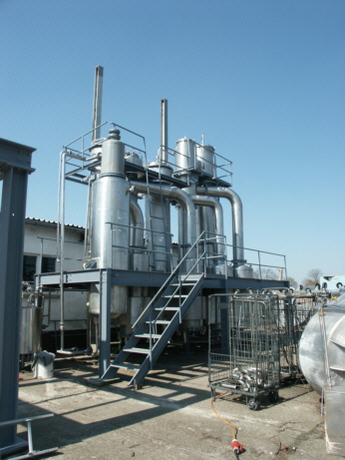|
Production of powdered milk
Production of powdered milk
[E18] [E19] [E20] [F8] [F14]
[F15] [F16] [I10] [D11]
The process
is the following:
- centrifugation
of cow milk to eliminate
impurities;
- standardization
of the composition in
complete solids and lipids to obtain a final product with constant
characteristics;
- thermal
treatment at 120-130°C for 30
seconds (the high temperature is necessary to normalise the mineral and
protein
component) and homogenization;
- concentration
through evaporation vacuum
at 45-55°C (or through cryoconcentration or inverted osmosis).
- dehydration
by spray-drying or lyophilization;
- packing
in light and humidity-impermeable
packages
In truth
powdered milk is obtained in
different ways:
- Spray
processes. These have
varying applications. The nebulisation of milk is performed in a
turbine at
7000-8000 rpm, placed in a tower with air at 120-150°C: in this way the
small
drops of milk escaping from the turbine are dried before reaching the
walls of
the tower. They drop to the bottom and are removed mechanically. In
other spray
processes, nebulisation is obtained by the compression through thin
holes, and
dehydration is obtained by the circulation of hot air. During the spray
processes, it is necessary to pre-concentrate the milk in order to
avoid
excessive nebulisation which involves an excessive absorption of the
air on the
particles of powdered milk, and the subsequent oxidative modification.
Powdered
milk must be immediately cooled and kept in an inert environment.
- Crosscurrent
processes. These heat the
nebulised milk in 70-metre towers while a slow air current or inert gas
is
injected from the bottom. The milk powder collects on the bottom and is
automatically removed.
- Foam
processes. The milk is
heated in advance at 63°C and is later vacuum concentrated to produce a
residual dry titre of 50%. It is then homogenized at 57° and, during
the
homogenization, gas nitrogen is blended into the mass. It is cooled to
10°C and
then heated to 49°C, shaking it in a vacuum. The product is fluffy and
soluble
due to the presence of gas inclusions.

For powdered
milk solubility is very
important; it is therefore submitted to instantaneity. The milk,
obtained via
the spray process, is sent into the instantaneity room on conveyors.
There it
is kept in contact with water up to a total of 10% of its weight. Later
it is
cooled down and dried up to 3-4% of water. Milk is easy soluble and
will keep
its solubility.
 8/13
8/13

|